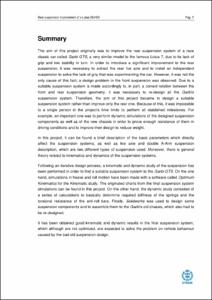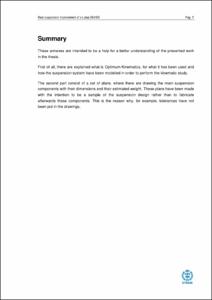Mostra el registre d'ítem simple
Rear suspension improvement of a Lotus SEVEN
| dc.contributor | Hernández Chiva, Emilio |
| dc.contributor.author | Garcia Lleixà, Marc |
| dc.contributor.other | Universitat Politècnica de Catalunya. Departament de Projectes d'Enginyeria |
| dc.date.accessioned | 2015-07-07T18:50:50Z |
| dc.date.available | 2015-07-07T18:50:50Z |
| dc.date.issued | 2015-01 |
| dc.identifier.uri | http://hdl.handle.net/2099.1/26524 |
| dc.description.abstract | The aim of this project originally was to improve the rear suspension system of a race classic car called Garbi GTS, a very similar model to the famous Lotus 7, due to its lack of grip and low stability in turn. In order to introduce a significant improvement to the rear suspension, it was necessary to extract the rear live axle and to install an independent suspension to solve the lack of grip that was experimenting the car. However, it was not the only cause of this fact; a design problem in the front suspension was observed. Due to a suitable suspension system is made accordingly to, in part, a correct relation between the front and rear suspension geometry, it was necessary to re-design all the Garbi’s suspension system. Therefore, the aim of this project became to design a suitable suspension system rather than improve only the rear one. Because of this, it was impossible to a single person in the project’s time limits to perform all stablished milestones. For example, an important one was to perform dynamic simulations of the designed suspension components as well as of the new chassis in order to prove enough resistance of them in driving conditions and to improve their design to reduce weight. In this project, it can be found a brief description of the basic parameters which directly affect the suspension systems, as well as live axle and double A-Arm suspension description, which are two different types of suspension used. Moreover, there is general theory related to kinematics and dynamics of the suspension systems. Following an iterative design process, a kinematic and dynamic study of the suspension has been performed in order to find a suitable suspension system to the Garbi GTS. On the one hand, simulations in heave and roll motion have been made with a software called Optimum Kinematics for the Kinematic study. The originated charts from the final suspension system simulations can be found in this project. On the other hand, the dynamic study consisted of a series of calculations to basically determine required stiffness of the springs and the torsional resistance of the anti-roll bars. Finally, Solidworks was used to design some suspension components and to assemble them to the Garbi’s old chassis, which also had to be re-designed. It has been obtained good kinematic and dynamic results in the final suspension system, which although are not optimized, are expected to solve the problem on vehicle behaviour caused by the bad old suspension design. |
| dc.language.iso | eng |
| dc.publisher | Universitat Politècnica de Catalunya |
| dc.rights | Attribution-NonCommercial-NoDerivs 3.0 Spain |
| dc.rights.uri | http://creativecommons.org/licenses/by-nc-nd/3.0/es/ |
| dc.subject | Àrees temàtiques de la UPC::Enginyeria mecànica::Disseny i construcció de vehicles::Automòbils |
| dc.subject.lcsh | Automobiles -- Design and construction |
| dc.subject.lcsh | Automobiles -- Springs and suspension |
| dc.title | Rear suspension improvement of a Lotus SEVEN |
| dc.type | Bachelor thesis |
| dc.subject.lemac | Automòbils -- Projectes i construcció |
| dc.subject.lemac | Automòbils -- Ressorts i suspensió |
| dc.rights.access | Open Access |
| dc.audience.educationlevel | Grau |
| dc.audience.mediator | Escola Tècnica Superior d'Enginyeria Industrial de Barcelona |
| dc.provenance | Aquest document conté originàriament altre material i/o programari no inclòs en aquest lloc web |
| dc.audience.degree | GRAU EN ENGINYERIA EN TECNOLOGIES INDUSTRIALS (Pla 2010) |



